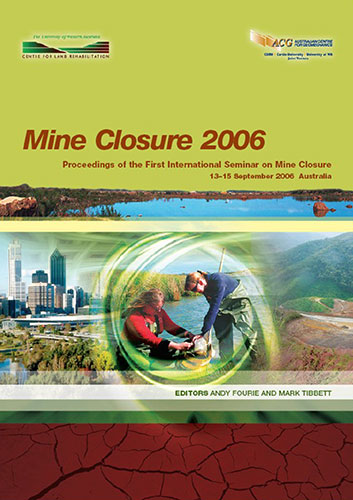Development of Key Performance Indicators for Rehabilitation, Murrin Murrin Nickel Operation

|
Authors: Loch, R; Stevens, T; Wells, G; Gerrard, R |
DOI https://doi.org/10.36487/ACG_repo/605_49
Cite As:
Loch, R, Stevens, T, Wells, G & Gerrard, R 2006, 'Development of Key Performance Indicators for Rehabilitation, Murrin Murrin Nickel Operation', in AB Fourie & M Tibbett (eds), Mine Closure 2006: Proceedings of the First International Seminar on Mine Closure, Australian Centre for Geomechanics, Perth, pp. 569-576, https://doi.org/10.36487/ACG_repo/605_49
Abstract:
The Murrin Murrin Nickel Cobalt Project (Project) which is owned by subsidiaries of Minara Resources Limited and Glencore International AG and operated by Murrin Murrin Operations Pty Ltd (MMO), is located approximately 60 km east of Leonora in the North Eastern Goldfields of Western Australia. The Project includes open cut pits from which nickel laterite ore is mined using conventional open cut techniques and a processing plant which uses High Pressure Acid Leach (HPAL) technology to extract and recover the nickel and cobalt from the ore. Over the life of the mine, approximately 2500 ha of waste dumps are expected to be constructed. Progressive rehabilitation of disturbed areas was committed to by MMO when it obtained Project approval. Based on current guidelines provided by the WA Department of Industry and Resources (DoIR), MMO is required to post an Environmental Performance Bond (Bond) on various areas disturbed by mining operations. Currently, for waste dumps, the rate is typically set at $10000 per hectare (DME, 2003). If Bonds simply accumulated over the life of the MMO, waste dumps alone would represent a bond requirement of $25,000,000. As Bonds (at differing rates) are also required for other areas of disturbance on the site, the potential total bond for MMO by completion of mining could be extremely large indeed. If no rehabilitation was done until completion of mining, MMO would not only have significant funds committed to performance bonds, but would then also need to provide a similar level of funding to carry out rehabilitation of the areas of disturbance. Funding that level of bonding plus rehabilitation requirements would create a considerable challenge for any company, illustrating that a commitment to progressive rehabilitation is both environmentally and economically responsible. Current DoIR guidelines for Bonds allow for their progressive return on the basis of rehabilitation progress (Table 1), providing a strong economic incentive for the site to carry out progressive rehabilitation during the life of the mine and keep commitments to Bonds to as low a level as possible. However, that strategy faces two challenges. The first is to achieve stable and sustainable rehabilitation reliably and cost-effectively. The second is to establish an effective process for the assessment of rehabilitation success and the progressive return of Bonds on the basis of that assessment. This paper describes the way in which MMO has dealt with both those challenges. Mine Closure 2006 ― Andy Fourie and Mark Tibbett (eds) © 2006 Australian Centre for Geomechanics, Perth, ISBN 0-9756756-6-4 Mine Closure 2006, Perth, Australia 569 Table 1 Suggested levels of Environmental Performance Bond reduction (DME 2003) Stage Action Completion Criteria Met Reduce bond to $/ha
References:
Department of Mines and Energy (1996) Guidelines for Mining in Arid Areas Western Australian Government, Perth.
Department of Industry and Resources (2003) Environmental Branch Bond Guideline, Western Australian Government,
Perth.
Department of Industry and Resources (2006) Guidelines for mining proposals in Western Australia, February 2006,
Western Australian Government, Perth.
Environmental Protection Agency (2006) Guidance for the Assessment of Environmental Factors, No 6. Rehabilitation
of terrestrial ecosystems, Western Australian Government, Perth.
Development of Key Performance Indicators for Rehabilitation,
Murrin Murrin Nickel Operation
R. Loch, et al.
576 Mine Closure 2006, Perth, Australia
© Copyright 2025, Australian Centre for Geomechanics (ACG), The University of Western Australia. All rights reserved.
View copyright/legal information
Please direct any queries or error reports to repository-acg@uwa.edu.au
View copyright/legal information
Please direct any queries or error reports to repository-acg@uwa.edu.au